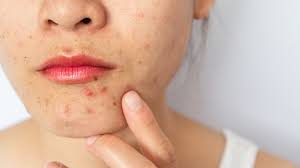
Acne vulgaris is a common skin condition that affects millions of individuals worldwide, often leading to the eruption of small pustules. The condition is primarily triggered by the skin bacterium Cutibacterium acnes. While various methods exist to inhibit the growth of this bacterium, such as antibiotics or hormonal treatments to reduce skin oil production, these approaches often come with undesirable side effects.
However, a recent study published in the journal Nanoscale has uncovered a potential breakthrough in acne treatment. Researchers from the University of South Australia, the University of Adelaide in Australia, and Aix-Marseille Universite in France have discovered that delivering an antibacterial compound inside microscopic envelopes could offer a promising remedy for acne vulgaris with fewer side effects.
The treatment in question is based on the potent antibiotic narasin, originally used to protect livestock and poultry from infections. Unlike many other antibiotics, C. acnes has not developed resistance to narasin. Recent experiments conducted in controlled laboratory conditions demonstrated the antibiotic’s effectiveness against the target pathogen.
The key innovation in this study lies in nanoparticle delivery. By encapsulating narasin within minuscule capsules, called nano-micelles, the researchers were able to significantly enhance the treatment’s impact. These nano-micelles are incredibly small, measuring only a fraction of the width of a human hair.
What makes nano-micelles particularly effective is their ability to penetrate the skin’s layers. In contrast to a simple water mixture of narasin, the specially designed nanoparticle delivery system increased the solubility of the antibiotic by over 100 times. This achievement was made possible by incorporating a compound called Soluplus, which not only boosted the solubility of the nano-micelles but also improved the drug’s delivery mechanism.
Pharmaceutical scientist Sanjay Garg, from the University of South Australia, highlighted the remarkable effectiveness of the micelle formulation in delivering narasin to acne-affected areas. Unlike the compound solution, which struggled to penetrate the skin’s layers, the nano-micelles showed great promise in permeating the skin.
While the researchers conducted their experiments using pig ear skin, further studies are needed to ensure that the drug effectively reaches the hair follicles beneath the skin, which is crucial for treating actual acne in humans.
This breakthrough comes at a time when existing acne remedies are losing their effectiveness due to antibiotic resistance. The innovative use of narasin delivered via nano-micelles offers hope for a more effective and potentially safer treatment for individuals struggling with acne vulgaris.
In conclusion, the discovery of this antibacterial compound delivery method represents a significant step forward in the quest for a better acne treatment, offering the potential to address this common skin condition with fewer side effects and improved efficacy. Further research and clinical trials are needed to validate these findings and bring this innovative approach to acne treatment to the forefront.